The Intel Core i9-9900K at 95W: Fixing The Power for SFF
by Ian Cutress on November 29, 2018 8:00 AM ESTCPU Performance: System Tests
Our System Test section focuses significantly on real-world testing, user experience, with a slight nod to throughput. In this section we cover application loading time, image processing, simple scientific physics, emulation, neural simulation, optimized compute, and 3D model development, with a combination of readily available and custom software. For some of these tests, the bigger suites such as PCMark do cover them (we publish those values in our office section), although multiple perspectives is always beneficial. In all our tests we will explain in-depth what is being tested, and how we are testing.
All of our benchmark results can also be found in our benchmark engine, Bench.
Application Load: GIMP 2.10.4
One of the most important aspects about user experience and workflow is how fast does a system respond. A good test of this is to see how long it takes for an application to load. Most applications these days, when on an SSD, load fairly instantly, however some office tools require asset pre-loading before being available. Most operating systems employ caching as well, so when certain software is loaded repeatedly (web browser, office tools), then can be initialized much quicker.
In our last suite, we tested how long it took to load a large PDF in Adobe Acrobat. Unfortunately this test was a nightmare to program for, and didn’t transfer over to Win10 RS3 easily. In the meantime we discovered an application that can automate this test, and we put it up against GIMP, a popular free open-source online photo editing tool, and the major alternative to Adobe Photoshop. We set it to load a large 50MB design template, and perform the load 10 times with 10 seconds in-between each. Due to caching, the first 3-5 results are often slower than the rest, and time to cache can be inconsistent, we take the average of the last five results to show CPU processing on cached loading.
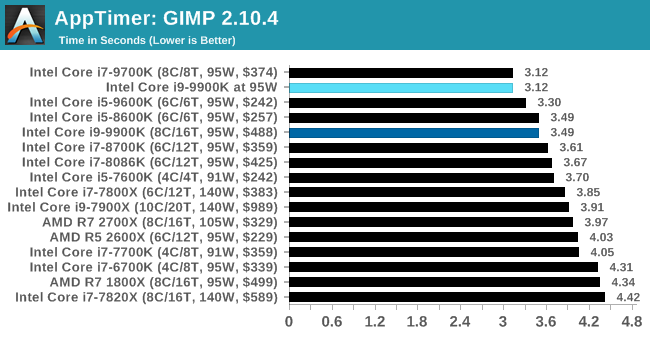
One of the interesting things in these benchmarks is that when in 95W mode, especially in shorter tests, the 9900K actually performs better than the full grunt settings. This could be because the system doesn't have to consider current limits of the power delivery, as 95W is the guaranteed limit no matter the loading.
FCAT: Image Processing
The FCAT software was developed to help detect microstuttering, dropped frames, and run frames in graphics benchmarks when two accelerators were paired together to render a scene. Due to game engines and graphics drivers, not all GPU combinations performed ideally, which led to this software fixing colors to each rendered frame and dynamic raw recording of the data using a video capture device.
The FCAT software takes that recorded video, which in our case is 90 seconds of a 1440p run of Rise of the Tomb Raider, and processes that color data into frame time data so the system can plot an ‘observed’ frame rate, and correlate that to the power consumption of the accelerators. This test, by virtue of how quickly it was put together, is single threaded. We run the process and report the time to completion.
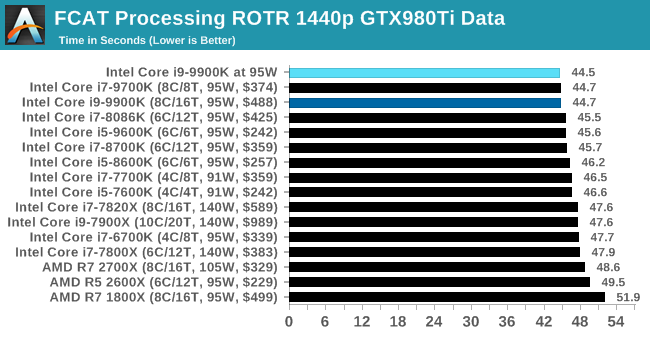
In a slightly longer test, the 9900K @ 95W eeks out the tiniest win.
3D Particle Movement v2.1: Brownian Motion
Our 3DPM test is a custom built benchmark designed to simulate six different particle movement algorithms of points in a 3D space. The algorithms were developed as part of my PhD., and while ultimately perform best on a GPU, provide a good idea on how instruction streams are interpreted by different microarchitectures.
A key part of the algorithms is the random number generation – we use relatively fast generation which ends up implementing dependency chains in the code. The upgrade over the naïve first version of this code solved for false sharing in the caches, a major bottleneck. We are also looking at AVX2 and AVX512 versions of this benchmark for future reviews.
For this test, we run a stock particle set over the six algorithms for 20 seconds apiece, with 10 second pauses, and report the total rate of particle movement, in millions of operations (movements) per second. We have a non-AVX version and an AVX version, with the latter implementing AVX512 and AVX2 where possible.
3DPM v2.1 can be downloaded from our server: 3DPMv2.1.rar (13.0 MB)
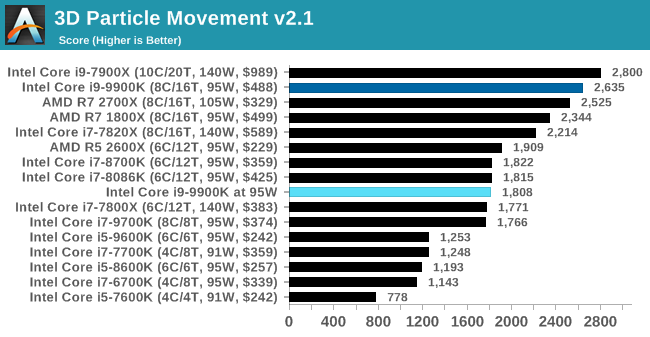
As we move onto something more substantial with all the threads, the 95W setting means that the result scores a heavy loss in 3DPM.
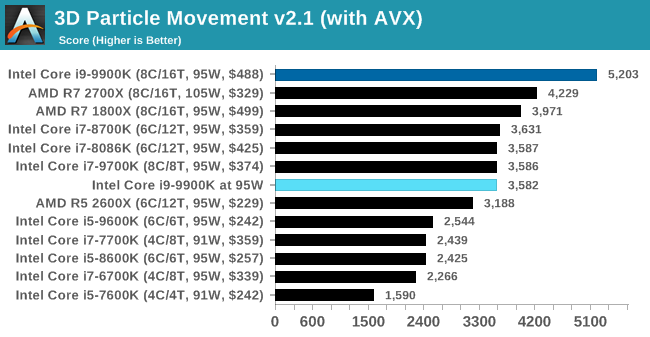
Dolphin 5.0: Console Emulation
One of the popular requested tests in our suite is to do with console emulation. Being able to pick up a game from an older system and run it as expected depends on the overhead of the emulator: it takes a significantly more powerful x86 system to be able to accurately emulate an older non-x86 console, especially if code for that console was made to abuse certain physical bugs in the hardware.
For our test, we use the popular Dolphin emulation software, and run a compute project through it to determine how close to a standard console system our processors can emulate. In this test, a Nintendo Wii would take around 1050 seconds.
The latest version of Dolphin can be downloaded from https://dolphin-emu.org/
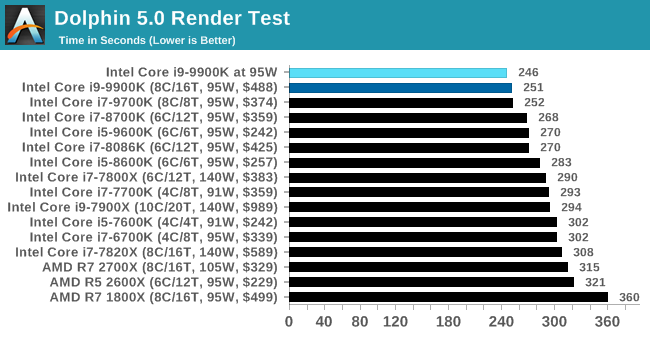
Dolphin is again a single threaded test, and the 9900K at 95W eeks out another small win.
DigiCortex 1.20: Sea Slug Brain Simulation
This benchmark was originally designed for simulation and visualization of neuron and synapse activity, as is commonly found in the brain. The software comes with a variety of benchmark modes, and we take the small benchmark which runs a 32k neuron / 1.8B synapse simulation, equivalent to a Sea Slug.
Example of a 2.1B neuron simulation
We report the results as the ability to simulate the data as a fraction of real-time, so anything above a ‘one’ is suitable for real-time work. Out of the two modes, a ‘non-firing’ mode which is DRAM heavy and a ‘firing’ mode which has CPU work, we choose the latter. Despite this, the benchmark is still affected by DRAM speed a fair amount.
DigiCortex can be downloaded from http://www.digicortex.net/
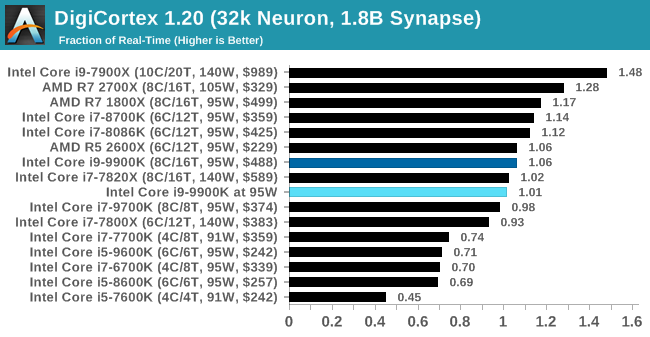
When it comes to a mixed benchmark like DigiCortex, the reduced power CPU actually performs around the same, given the same DRAM speed on both setups.
y-Cruncher v0.7.6: Microarchitecture Optimized Compute
I’ve known about y-Cruncher for a while, as a tool to help compute various mathematical constants, but it wasn’t until I began talking with its developer, Alex Yee, a researcher from NWU and now software optimization developer, that I realized that he has optimized the software like crazy to get the best performance. Naturally, any simulation that can take 20+ days can benefit from a 1% performance increase! Alex started y-cruncher as a high-school project, but it is now at a state where Alex is keeping it up to date to take advantage of the latest instruction sets before they are even made available in hardware.
For our test we run y-cruncher v0.7.6 through all the different optimized variants of the binary, single threaded and multi-threaded, including the AVX-512 optimized binaries. The test is to calculate 250m digits of Pi, and we use the single threaded and multi-threaded versions of this test.
Users can download y-cruncher from Alex’s website: http://www.numberworld.org/y-cruncher/
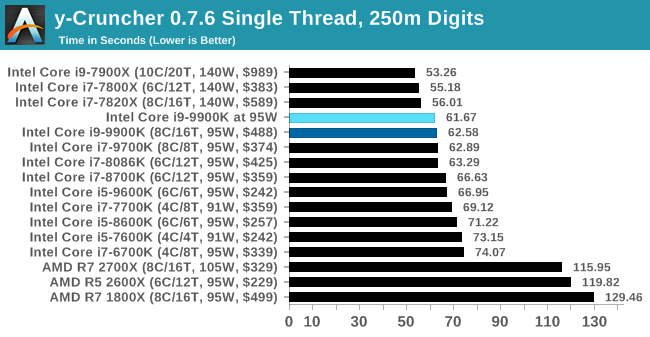
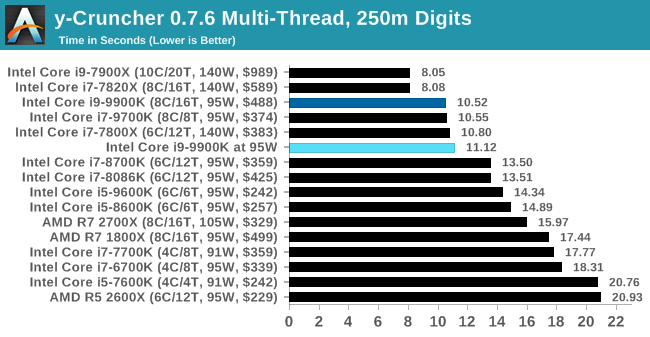
yCruncher shows another small win for the 9900K at 95W in single threaded mode, although this turns into a loss when all the threads are primed with AVX2 code.
Agisoft Photoscan 1.3.3: 2D Image to 3D Model Conversion
One of the ISVs that we have worked with for a number of years is Agisoft, who develop software called PhotoScan that transforms a number of 2D images into a 3D model. This is an important tool in model development and archiving, and relies on a number of single threaded and multi-threaded algorithms to go from one side of the computation to the other.
In our test, we take v1.3.3 of the software with a good sized data set of 84 x 18 megapixel photos and push it through a reasonably fast variant of the algorithms, but is still more stringent than our 2017 test. We report the total time to complete the process.
Agisoft’s Photoscan website can be found here: http://www.agisoft.com/
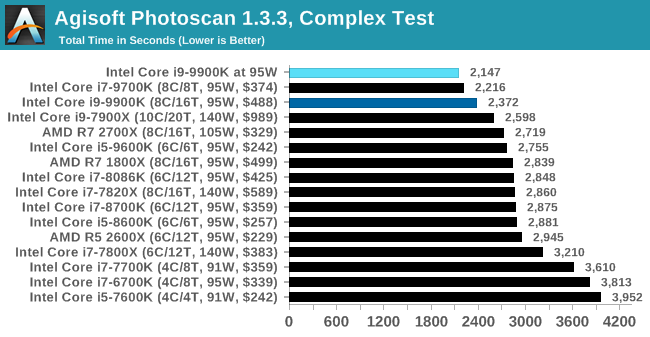
Photoscan is a mixed workload test, with certain portions being purely singe threaded and others being multithreaded. The 9900K at 95W wins by a good amount here.













101 Comments
View All Comments
TechSideUp - Sunday, December 2, 2018 - link
Can you show me where your getting this i9-9900k for $488? Lolpeevee - Monday, December 3, 2018 - link
" Alex Yee, a researcher from NWU and now software optimization developer, that I realized that he has optimized the software like crazy to get the best performance."What CPU he optimized it for? Let me guess... the one he has in his room.
tviceman - Monday, December 3, 2018 - link
I'd like to see what kind of performance gains may be had with an undervolt when TDP limited.TheJian - Tuesday, December 4, 2018 - link
I think people are confusing WATTS USED with TDP (amount of HEAT a chip puts off that your HSF or case etc has too be able to accommodate to cool said chip). They are telling manufacturers of laptops, pc's etc how good their cooling design needs to be to keep the chip from heating up.THERMAL DESIGN POWER (point might be more accurate, as some use it), is just as it sounds. THERMAL, er, uh, HEAT. Get it? I'm confused by everyone's confusion...LOL.
https://www.windowscentral.com/what-tdp-and-why-sh...
Perhaps a bit better explanation than anandtech is providing. Maybe they need an A+ course?
"TDP ≠ power draw?"
"Not quite, no. TDP doesn't equate to how much power will be drawn by the component in question, but that doesn't mean you can't use the value provided as an estimation."
"TDP is not — however — a direct measure of how much power a component will draw, but it can be a good indicator."
So, don't expect watts PULLED from a wall to equal a quoted TDP. That isn't what it is, although it may come close to meaning it...ROFL.
If you had a 100% efficient chip (as someone else noted isn't possible...yet?), your chips TDP rating would be ZERO. It would not require anything to cool it. See the point?
https://en.wikipedia.org/wiki/Thermal_design_power
"The thermal design power (TDP), sometimes called thermal design point, is the maximum amount of heat generated by a computer chip or component (often the CPU or GPU) that the cooling system in a computer is designed to dissipate under any workload."
Not exactly watts used right?
https://fullforms.com/TDP
"What does TDP mean?
Thermal Design Power (TDP), sometimes called Thermal Design Point, is a metric that is expressed in watts. TDP refers to the amount of power/heat a cooling system (like fan, heatsink) is expected to dissipate to prevent overheating."
Again, not watts used. I could point to another dozen, but people should get the point. Despite whatever Intel/AMD think it means year to year (ROFL), it's heat.
https://www.overclockers.com/forums/showthread.php...
Same story from OC people. To each his own I guess, but many seem confused about why things blow past tdp (because it's not WATTS). What is the chips temp when it blows past those TDP numbers at stock settings? Is it 150 instead of 95 or whatever? I mean if Dell or someone designs their slim pc's for 95w it likely won't work to well if it's going to 150 temps with a box that is designed to cool 95-100w right? Again, the definition used here really don't work IMHO (and everyone else I seem to look up...LOL). But hey, maybe my old A+ test was wrong (I'm old, maybe I'm just not recalling things correctly, and all the web is wrong too) :) I doubt it ;)
Gastec - Wednesday, June 19, 2019 - link
Perpetuum mobile IS impossible. And I don't want a CPU that's advertised as consuming 95W to 110W (give more than take the PSU inefficiency and other losses on the pipe) to automatically overclock to 170 W because of review benchmarks. I want it to be set BY DEFAULT at max. 95-110W and I also want it to do 5GHz on all cores @ 95-110W, as advertised:) Then I would pay 490€ for it.DennisBaker - Tuesday, December 4, 2018 - link
I wanted to build a new PC on Black Friday, and I bought an i9-9900k. I never overclock and typically buy a locked/non-k CPU but couldn't wait until next year. I also always use a SFF case (Cooler Master Elite 130).This is a great article, but I'm not sure how to actually set the bios for a 95w max cpu setting.
I have the Asrock z390 phantom gaming-itx/ac motherboard:
http://asrock.pc.cdn.bitgravity.com/Manual/Z390%20...
I've been googling without success and figured I would just ask here if there is a general guide for this.
DennisBaker - Tuesday, December 4, 2018 - link
Set to:Long Duration Power Limit: 95
Long Duration Maintained: Auto
Short Duration Power Limit: 95
Seems like that should work.
0ldman79 - Thursday, December 6, 2018 - link
I guess the 95w limit prevented whatever resource snag or thermal throttling issues that was happening with the unlimited version.That would explain the benches where it won vs the unlimited 9900k.
HikariWS - Thursday, December 13, 2018 - link
Great article! I've been guessing about turbo values for years and this aticle answered it all!!Of course we need more transparency from Intel, I suppose this info is left for marketers to release and they think we'd not understand, so they just leave it hidden.
It's great how the same chip can be used on a small form factor and on a big E-ATX case. Modern turbo makes manual overclocking almost not needed, left for watercooling or maybe some manual Vcore setting.
It's basicly a matter of having a good case, a great cooler, and live in Europe to be able to keep 4700MHz all the time!
I wish Intel would release a top performing CPU with 4 core and no IGP, that would do 4.5GHz base and 5.5GHz All Core Turbo without watercooling. We don't need more than 4 cores.
misources - Sunday, May 10, 2020 - link
Nice article about Intel Core i9. please visit my site for more tutorial www.misources.com